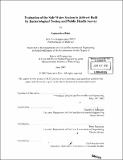Evaluation of the safe water system in Jolivert Haiti by bacteriological testing and public health survey
Author(s)
Brin, Geneviève, 1979-
DownloadFull printable version (10.40Mb)
Other Contributors
Massachusetts Institute of Technology. Dept. of Civil and Environmental Engineering.
Advisor
Daniele S. Langtagne.
Terms of use
Metadata
Show full item recordAbstract
The Centers for Disease Control and Prevention's (CDC) Safe Water System (SWS) is intended for use in developing countries and comprises three key elements: locally produced hypochlorite solution, safe storage of drinking water in the household, and community education about safe drinking water. In Haiti, only half of the 8 million inhabitants have access to safe water. Therefore, a SWS was implemented in Jolivert, a village in the Northwest of the country, in January 2002. The pilot project now reaches 200 households in the area. In order to provide a framework for project expansion, the pilot project was evaluated by: 1) a health survey conducted in 56 households using the system and 64 non-using households, 2) bacteriological tests of water from each water source and from each household drinking water in the health survey, and 3) chlorine residual tests in each household with the system. From a health perspective, the use of the SWS reduces diarrhea incidence by 40 percent. If there is chlorine residual in the drinking water, diarrhea incidences are reduced by 60 percent. However, it does not reduce diarrhea incidences for children under five years old, which is the main target age-category population. It is hypothesized that this age group is exposed to waterborne disease via other mechanisms than drinking water. The use of the system reduces the number of total coliform colonies by a factor of ten and the number of E.coli colonies by a factor of twenty. Moreover, if the water presents chlorine residual (indicating safe use of the system), the presence of total coliform units is lowered by a factor close to one hundred, and the tests show no presence of E.coli. The results show that the project is successful and should be expanded. However, logistic issues need to be resolved. First, a correct pricing needs to be chosen to ensure the project's sustainability. Second, the hypochlorite solution has to be easily available in remote regions. Third, schools should play a role in the expansion of the project as promoters and educators. Lastly, further research is recommended to determine why a health benefit was not seen for children under five years old.
Description
Thesis (M.Eng.)--Massachusetts Institute of Technology, Dept. of Civil and Environmental Engineering, 2003. Includes bibliographical references (leaves 79-81).
Date issued
2003Department
Massachusetts Institute of Technology. Department of Civil and Environmental EngineeringPublisher
Massachusetts Institute of Technology
Keywords
Civil and Environmental Engineering.